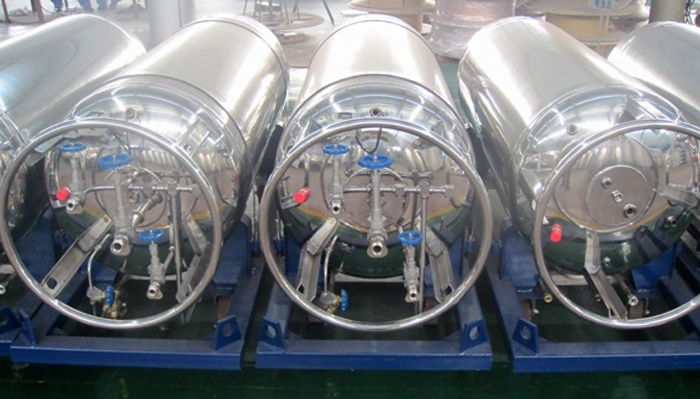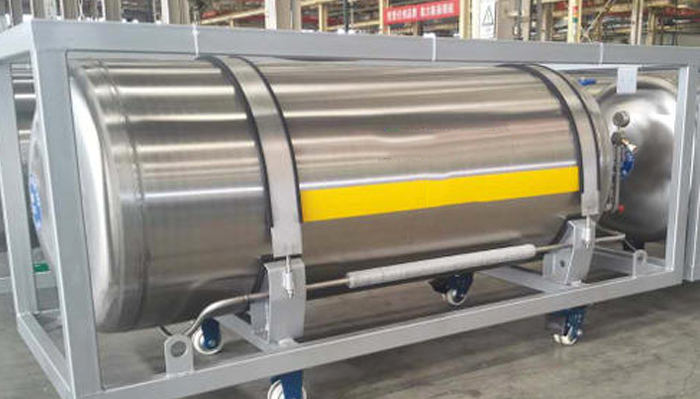Product Category
Thermal insulation materials for cryogenic storage tanks
Date: Jul 22, 2020

The principle of thermal insulation of cryogenic storage tanks: In thermal insulation engineering, materials with thermal conductivity λ≤0.2w/(m·k) are called thermal insulation materials.
Insulation materials used for cryogenic containers in cryogenic coolers, cryogenic circulators and other equipment should generally meet the following requirements:
1. The thermal conductivity should be small, which should be 0.024-0.139W/ (m·K). The use of thermal insulation materials with low thermal conductivity can not only reduce the thickness of the thermal insulation layer, but also reduce the size and save investment.
2. The low density can reduce the supporting structure of structures, equipment and pipelines; and materials with low density have a small thermal conductivity within a certain range.
3. Low water absorption and good water resistance. If the water absorption is high, the thermal insulation performance will be deteriorated. Although the hot side of the thermal insulation structure is provided with a moisture-proof vapor barrier, the vapor permeability resistance of any moisture-proof vapor barrier is not infinite, and it is difficult to completely prevent water vapor from entering the insulation material. The vapor permeability resistance of the cold side is close to infinity, and water vapor cannot be discharged from the cold side. In addition, it is also required that the material does not rot, loose, and has no significant decrease in mechanical strength after absorbing a small amount of moisture. Generally, it is required that the water absorption rate of the thermal insulation material is not more than 5%, and the thermal insulation performance does not decrease much after moisture absorption.
4. High mechanical strength, should have certain compressive and tensile strength, and be able to withstand certain mechanical shocks. Dimensional stability is better. Otherwise, after a period of use, it will be broken and sink to the bottom of the insulation structure, destroying the insulation effect of the insulation structure.  5. Good fire resistance, the material itself should be non-flammable or non-flammable. If the material is combustible, it should be self-extinguishing.
5. Good fire resistance, the material itself should be non-flammable or non-flammable. If the material is combustible, it should be self-extinguishing.
6. Good low-temperature resistance. The structure will not be damaged and the mechanical strength will not be reduced in the low-temperature range of use. It will not be damaged and the strength will not be reduced during the periodic freeze-thaw cycle.
7. Non-toxic and odorless, durable, able to resist or avoid insects and rat bites.
8. Convenient construction, easy to cut and paste. The environment is acceptable, that is, no or slight damage to the environment.
In fact, there is no thermal insulation material that fully meets the above requirements. Various thermal insulation materials have better performance in some aspects, but have shortcomings in the other. When selecting, a comprehensive analysis and comparison should be made according to the specific conditions such as the use requirements, the structure of the insulation structure, the technical performance of the material, and the price, and then make a decision.
Insulation materials used for cryogenic containers in cryogenic coolers, cryogenic circulators and other equipment should generally meet the following requirements:
1. The thermal conductivity should be small, which should be 0.024-0.139W/ (m·K). The use of thermal insulation materials with low thermal conductivity can not only reduce the thickness of the thermal insulation layer, but also reduce the size and save investment.
2. The low density can reduce the supporting structure of structures, equipment and pipelines; and materials with low density have a small thermal conductivity within a certain range.
3. Low water absorption and good water resistance. If the water absorption is high, the thermal insulation performance will be deteriorated. Although the hot side of the thermal insulation structure is provided with a moisture-proof vapor barrier, the vapor permeability resistance of any moisture-proof vapor barrier is not infinite, and it is difficult to completely prevent water vapor from entering the insulation material. The vapor permeability resistance of the cold side is close to infinity, and water vapor cannot be discharged from the cold side. In addition, it is also required that the material does not rot, loose, and has no significant decrease in mechanical strength after absorbing a small amount of moisture. Generally, it is required that the water absorption rate of the thermal insulation material is not more than 5%, and the thermal insulation performance does not decrease much after moisture absorption.
4. High mechanical strength, should have certain compressive and tensile strength, and be able to withstand certain mechanical shocks. Dimensional stability is better. Otherwise, after a period of use, it will be broken and sink to the bottom of the insulation structure, destroying the insulation effect of the insulation structure.

6. Good low-temperature resistance. The structure will not be damaged and the mechanical strength will not be reduced in the low-temperature range of use. It will not be damaged and the strength will not be reduced during the periodic freeze-thaw cycle.
7. Non-toxic and odorless, durable, able to resist or avoid insects and rat bites.
8. Convenient construction, easy to cut and paste. The environment is acceptable, that is, no or slight damage to the environment.
In fact, there is no thermal insulation material that fully meets the above requirements. Various thermal insulation materials have better performance in some aspects, but have shortcomings in the other. When selecting, a comprehensive analysis and comparison should be made according to the specific conditions such as the use requirements, the structure of the insulation structure, the technical performance of the material, and the price, and then make a decision.
Last article:
Next article:
Send Your Inquiry
We not only provide a good product, but also provide high quality service. If you are interested in our products,
you can contact us in the following ways.
you can contact us in the following ways.







